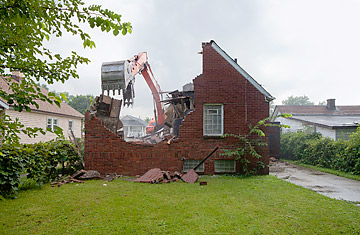
A home being destroyed in the Lee-Miles area of Cleveland
(4 of 5)
The Hubbard plan would help bring down interest on payments, but it wouldn't deal with the fact that so many homes are still underwater. On that score, Harvard professor Martin Feldstein, formerly Ronald Reagan's top economic adviser, has proposed reducing mortgage debt by cutting the loan principal with a government subsidy issued with very low interest rates. If the market stabilized, Feldstein says, the cost to taxpayers would be $200 billion. The new loan would discourage homeowners from walking away from their houses by making their other personal assets, like bank accounts or cars, also subject to repossession if they defaulted again.
Perhaps the best chance for principal reduction may come for those who are current on their payments and have loans with the biggest mortgage servicers. Bank of America, Wells Fargo, JPMorgan Chase and others may soon be forced by state attorneys general, who are seeking a collective $20 billion in penalties for faulty lending, to write down some individual mortgages. "We think there's a good chance that targeted principal reduction will be part of our deal," says Geoff Greenwood, spokesman for Iowa attorney general Tom Miller, who is leading the negotiations on behalf of 50 state AGs.
2 RIP OFF THE BANDAGE
Geanakoplos says government should do something simple and perhaps coldhearted: save the good loans and abandon the bad ones by writing down only those 1.2 million deeply underwater loans guaranteed by Fannie and Freddie whose borrowers are still current on their payments. Seriously delinquent loans would be left to fail.
He and other economists in and out of government believe that for many underwater homeowners, even tweaks to the principal won't be enough to save their homes. "The fact of the matter is that you've got some people who are just too underwater, too behind. All it's going to do is prolong the inevitable," says one government official involved in principal-reduction negotiations with the banks.
As coldhearted as it sounds, speedy foreclosure is often the fastest and most effective way to get rid of burdensome mortgage debt and boost the economy. Two counties in the metro-Washington area show how. Prices boomed in both Prince William County, Virginia, and Prince George's County, Maryland, in the mid-2000s. Both had a higher-than-average share of subprime mortgages. And when the bust came, prices in both areas collapsed. The result was mass foreclosure. Prince William had some of the highest foreclosure rates in the country. Prince George's accounted for nearly a quarter of all foreclosures in Maryland.
Four years later, their stories have diverged. Prices in Prince William County have rebounded nearly 50% from their early-2009 lows. Foreclosures have shrunk dramatically. Multiple offers are back, and it takes just 47 days on average to sell a home. By contrast, home prices in Prince George's have fallen 18% in the past year, and foreclosures or distressed sales account for about 57% of all transactions.
What happened? Housing economist Thomas Lawler says the problem isn't too many foreclosures; it's too few. Looking at the two counties, he found that Virginia is one of the fastest and easiest places in the nation for banks to take houses from borrowers who aren't paying. Foreclosures came early and often in Prince William. But in 2008, Maryland passed a law that lengthened the foreclosure process to 150 days from just 15. Another law passed in 2010 forces banks to offer more modifications to delinquent homeowners. There are of course other differences between the two counties — Prince William has a slightly lower unemployment rate — but Lawler believes foreclosure rules have been key. "More foreclosures would have allowed the market to clear itself and recover earlier," he says.
The better housing market has in part translated into a better economy for Prince William County. Prince William's job market has snapped back faster since the recession, topping out at an unemployment rate of 6.6% in February 2010 before dropping steadily. In June, the latest month for which figures are available, the rate fell to 5.3%, from 5.8% a year earlier. In Prince George's, unemployment reached a high of 7.9% before dropping in 2010. Recently, unemployment in Prince George's rose again, to 7.5% in June, up from 7.4% a year ago. Now Democrats and Republicans in a number of states, including Ohio, Colorado and Illinois, are pursuing laws that would fast-track foreclosures.
3 DON'T OWN — RENT
With as many as 5 million more foreclosures still expected by some economists before the crisis ends, the approach of speeding evictions raises an obvious question: Where will these millions of people live? The Obama Administration, which has spent $7.6 billion on housing for the evicted, recently proposed that such people should go back into foreclosed homes as renters.
Since the housing crisis began, economists like Yale's Robert Shiller have made the point that homeownership in the U.S. has been unwisely fetishized, given that it is a historically bad investment compared with stocks and bonds, costs the government some $100 billion a year in subsidies (in the form of mortgage-interest and property-tax deductions) and covers up fundamental economic problems — like stagnating wages that erode a middle-class lifestyle — with debt.
